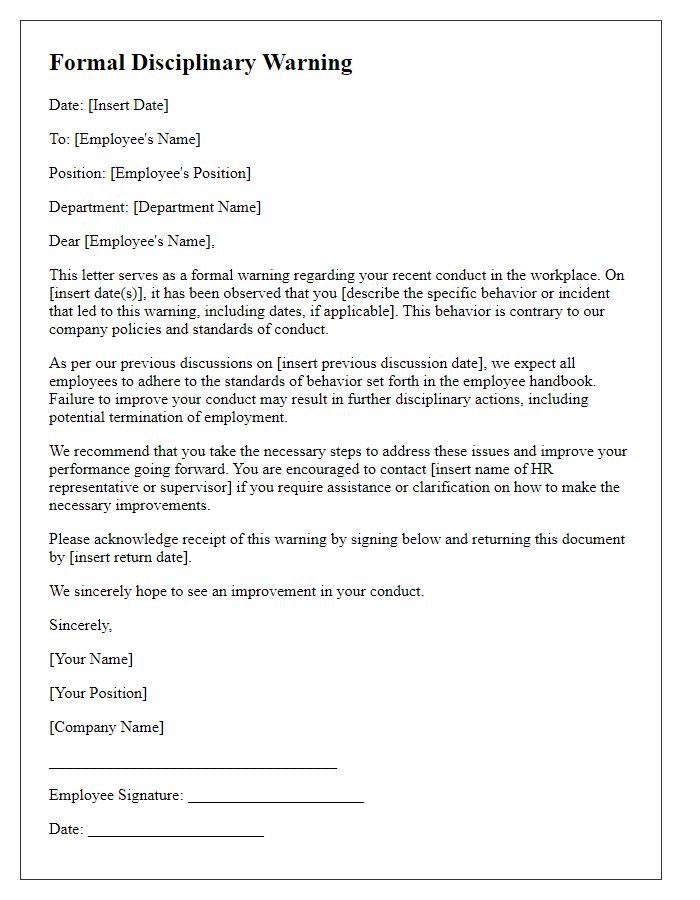Navigating the complexities of formal disciplinary action can be daunting, but a well-structured letter can make all the difference. In this article, we'll explore the essential components of a disciplinary action letter, ensuring that it conveys professionalism while maintaining clarity and fairness. From outlining the concerns to detailing the next steps, clear communication is key in fostering understanding and resolution. Ready to dive deeper into crafting the perfect disciplinary letter? Let's get started!

Employee's Name and Details
The disciplinary process plays a crucial role in maintaining workplace standards and ensuring compliance with organizational policies. During a formal disciplinary action, matters such as employee behavior (e.g., attendance, performance) and adherence to guidelines are addressed. For instance, an employee's repeated tardiness (more than three instances in a month) can lead to a need for corrective measures. In addition, records of previous warnings or discussions (dating back to March 2023) must be reviewed to provide context for the current action. The outcome can range from a written warning to suspension, depending on the severity of the infraction and the organization's policies outlined in the employee handbook. This systematic approach ensures fairness and transparency in the decision-making process, thereby fostering a disciplined work environment.
Description of Incident
A formal disciplinary action letter typically includes a detailed description of an incident involving employee misconduct or violation of company policies. For example, on March 10, 2023, at the corporate office in New York City, an employee was observed repeatedly arriving late to work, specifically after 9:00 AM, in violation of the established attendance policy requiring a start time of 8:30 AM. During this period, the employee had documented lateness on four separate occasions over a two-month span. Furthermore, on April 15, 2023, the employee was found using company resources for personal business during work hours, including accessing non-work-related websites, which contravenes the company's code of conduct regarding proper use of company time and resources. Such actions not only disrupted team operations but also set a poor example for other staff members.
Policy Violation
Formal disciplinary action for policy violations can have significant implications for workplace culture and employee accountability. The process often involves a documented review of the employee's behavior against company policies, such as attendance, ethics, or harassment grievances. Documentation must detail the specific incident, including dates, times, and any witness accounts, usually following the organization's standard operating procedures set forth in the employee handbook. The disciplinary action may involve a range of responses, from verbal warnings to formal written reprimands or even termination, which must comply with local labor laws. Clear communication about the consequences and expectations for future behavior is crucial for maintaining organizational integrity and ensuring a fair outcome for all involved parties.
Disciplinary Action Being Taken
Disciplinary actions are formal measures taken by organizations to address employee misconduct or performance issues. This process often includes a structured notification outlining the specific violation, associated evidence, and potential consequences. Employees might face actions ranging from verbal warnings to suspension or termination based on the severity of the incident. The disciplinary action letter itself must include critical information such as the date of the occurrence, the policies violated, and a clear description of the expectations moving forward. Procedures generally align with workplace regulations, ensuring fairness and accountability, adhering to guidelines set forth by entities such as the Equal Employment Opportunity Commission (EEOC).
Consequences of Future Violations
In formal disciplinary procedures, outlined consequences serve as a significant deterrent to future violations within organizations or workplaces. For instance, a company may impose a written warning for a first-time offense, clearly detailing the specific infraction and referencing the employee handbook (Section 5.2) that governs conduct. If subsequent violations occur, this could escalate to suspension, often for a period of three to five working days, impacting the employee's income as well as their standing in the organization. Repeated breaches after these actions may result in termination of employment, following an established protocol that includes a thorough investigation and an opportunity for the employee to respond. Maintaining records of these actions, using incident report forms from Human Resources, provides a paper trail necessary for legal protection and ensures all parties understand the expectations moving forward.













Comments